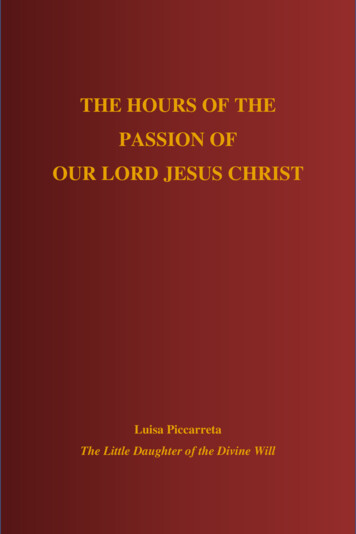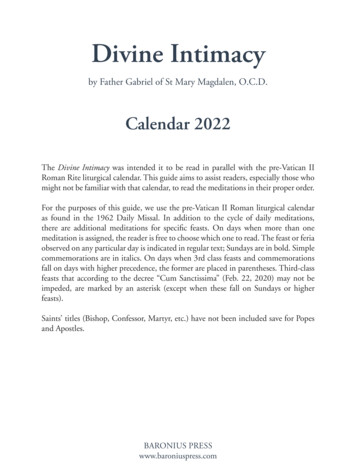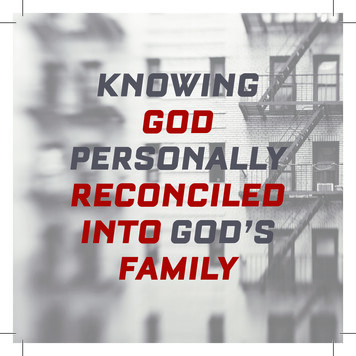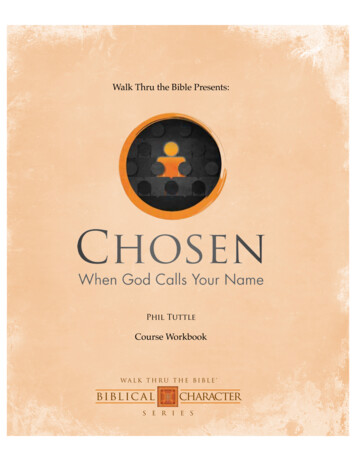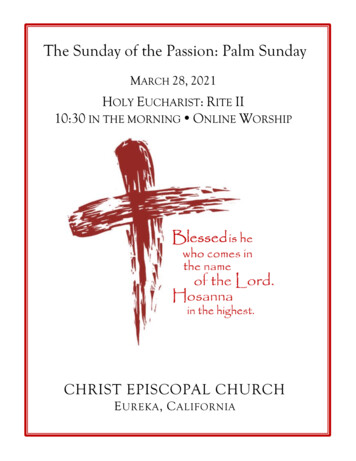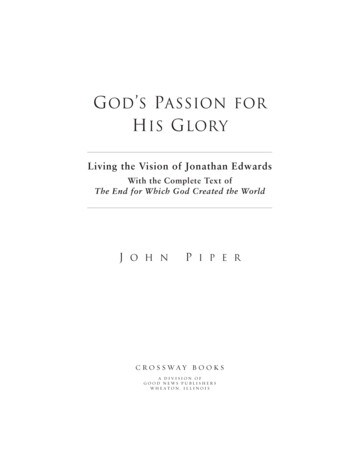
Transcription
G OD ’S PASSION FORH IS G LORYLiving the Vision of Jonathan EdwardsWith the Complete Text ofThe End for Which God Created the WorldJ O H NP I P E RC R O S S W AY B O O K SA DIVISION OFGOOD NEWS PUBLISHERSWHEATON, ILLINOIS
God’s Passion for His GloryCopyright 1998 by John PiperPublished by Crossway BooksA division of Good News Publishers1300 Crescent StreetWheaton, Illinois 60187All rights reserved. No part of this publication may be reproduced, stored in aretrieval system or transmitted in any form by any means, electronic, mechanical,photocopy, recording or otherwise, without the prior permission of the publisher,except as provided by USA copyright law.Unless otherwise indicated, Bible quotations are taken from The New AmericanStandard Bible, copyright 1960, 1962, 1963, 1968, 1971, 1972, 1975, 1977,and 1995 by The Lockman Foundation, and are used by permission.Cover design: D2 DesignWorksCover Photo: Dale Sanders/MasterfileFirst printing, 1998Printed in the United States of AmericaLibrary of Congress Cataloging-in-Publication DataPiper, John, 1946God’s passion for his glory : living the vision of Jonathan Edwardswith the complete text of “The end for which God created the world”by Jonathan Edwards / John Piper.p.cm.Includes bibliographical references and index.ISBN 1-58134-007-91. Edwards, Jonathan, 1703-1758. 2. Creation—History ofdoctrines—18th century. 3. Glory of God—History ofdoctrines—18th century. 4. Edwards, Jonathan, 1703-1758. End forwhich God created the world. 5. Creation—Early works to 1800.6. Glory of God—Early works to 1800. I. Title.BT695.P57 3090812071106100590480376025
TOJ O N AT H A N E D WA R D S“God is not the God of the deadbut of the living; for all live to Him.”L U K E2 0 : 3 8The emanation or communication of the divine fullness,consisting in the knowledge of God, love to him, and joyin him, has relation indeed both to God and the creature:but it has relation to God as its fountain, as the thingcommunicated is something of its internal fullness. Thewater in the stream is something of the fountain; and thebeams of the sun are something of the sun. And again,they have relation to God as their object: for the knowledge communicated is the knowledge of God; and thelove communicated, is the love of God; and the happinesscommunicated, is joy in God. In the creature’s knowing,esteeming, loving, rejoicing in, and praising God, theglory of God is both exhibited and acknowledged, hisfullness is received and returned. Here is both an emanation and remanation. The refulgence shines upon and intothe creature, and is reflected back to the luminary. Thebeams of glory come from God, are something of God,and are refunded back again to their original. So that thewhole is of God, and in God, and to God; and he is thebeginning, and the middle, and the end.Jonathan EdwardsThe End for Which God Created the World
TABLE OF CONTENTSPrefacexiAcknowledgmentsxvP A R TO N EA Personal Encounter with Jonathan Edwardsby John PiperCHAPTER ONE:The End for Which God Created the WorldWhy Publish an Old Book?A Personal and Public Concern21CHAPTER TWO:Jonathan Edwards, The Man and His LifeLearning from an Unmodern Evangelical49CHAPTER THREE:Jonathan Edwards, A Mind in Love with GodThe Private Life of a Modern Evangelical77CHAPTER FOUR:Jonathan Edwards, Enjoying God and theTransformation of CultureThe Public Life of a Modern Evangelical99P A R TT W OThe End for Which God Created the Worldby Jonathan EdwardsA Note on How to ReadThe End for Which God Created the World117Concerning the Text Used in This Edition ofThe End for Which God Created the World121INTRODUCTION:Containing Explanations of Terms andGeneral Positions125CHAPTER ONE:Wherein Is Considered What Reason TeachesConcerning This Affair137SECTION ONE:Some things observed in general whichreason dictates137SECTION TWO:Some further observations concerning thosethings which reason leads us to suppose Godaimed at in the creation of the world146
SECTION THREE:Wherein it is considered how, on the suppositionof God’s making the aforementioned things hislast end, he manifests a supreme and ultimateregard to himself in all his works152SECTION FOUR:Some objections considered, which may be madeagainst the reasonableness of what has beensaid of God making himself his last end162CHAPTER TWO:Wherein It Is Inquired What Is to Be Learned fromHoly Scriptures Concerning God’s Last Endin the Creation of the World183SECTION ONE:The Scriptures represent God as making himselfhis own last end in the creation of the world183SECTION TWO:Wherein some positions are advanced concerning ajust method of arguing in this affair from what wefind in the Holy Scriptures185SECTION THREE:Particular texts of Scripture which show that God’sglory is an ultimate end of the creation191SECTION FOUR:Places of Scripture that lead us to suppose that God 210created the world for his name, to make hisperfections known; and that he made it for his praiseSECTION FIVE:Places of Scripture from whence it may be argued220that communication of good to the creature was onething which God had in view as an ultimate end ofthe creation of the worldSECTION SIX:Wherein is considered what is meant by the glory of 229God and the name of God in Scripture, when spokenof as God’s end in his worksSECTION SEVEN:Showing that the ultimate end of the creationof the world is but one, and what that one end is241A Note on Resources: Desiring God Ministries253Scripture Index255Person Index261Subject Index263
OTHER BOOKSBY THE AUTHORLove Your Enemies: Jesus’ Love Command in the SynopticGospels and the Early Christian Paraenesis (Baker Book House,1991, orig. 1979)The Justification of God: An Exegetical and Theological Study ofRomans 9:1-23; 2nd Edition (Baker Book House, 1993, orig.1983)The Supremacy of God in Preaching (Baker Book House, 1990)The Pleasures of God: Meditations on God’s Delight in Being God(Multnomah Press, 1991)Recovering Biblical Manhood and Womanhood: A Response toEvangelical Feminism (edited with Wayne Grudem, CrosswayBooks, 1991)What’s the Difference: Manhood and Womanhood DefinedAccording to the Bible (Crossway Books, 1991)Let the Nations Be Glad: The Supremacy of God in Missions(Baker Book House, 1993)The Purifying Power of Living by Faith in Future Grace(Multnomah Press, 1995)Desiring God: Meditations of a Christian Hedonist (MultnomahPress, revised 1996)A Hunger for God: Desiring God through Fasting and Prayer(Crossway Books, 1997)A Godward Life: Savoring the Supremacy of God in All of Life(Multnomah Press, 1997)
PREFACEThe longer I live, the more clearly I see my dependence onthose who have gone before. The more I know of what others have thought, the less original my thinking appears. Iam content to have it so. For, at least in the realm of truth, theancient Preacher does not overstate the case when he says: “Thereis nothing new under the sun” (Ecclesiastes 1:9).This book is witness to my calling as a secondary teacher, nota primary one. Jonathan Edwards is a primary teacher in theChristian church; I am secondary. The difference was described byMortimer Adler in 1939:[The secondary teacher] should regard himself as learning fromthe masters along with his [students]. He should not act as if hewere a primary teacher, using a great book as if it were justanother textbook of the sort one of his colleagues might write. Heshould not masquerade as one who knows and can teach by virtueof his original discoveries. . . . The primary sources of his ownknowledge should be the primary sources of learning for his students, and such a teacher functions honestly only if he does notaggrandize himself by coming between the great books and their. . . readers. He should not “come between” as a nonconductor,but he should come between as a mediator—as one who helps theless competent make more effective contacts with the best minds.1This is the role I want to play in relation to Jonathan Edwards andhis book,2 The End for Which God Created the World. JonathanEdwards is in a class by himself in American history, perhaps inthe history of Christendom. This will become plain in the pagesthat follow. Paul Ramsey, the editor of Edwards’s Ethical Writings1Mortimer Adler, How to Read a Book (New York: Simon and Schuster, 1940), p. 60.Strictly speaking, The End for Which God Created the World is half a book, since it was originally published in 1765 (seven years after Edwards’s death) as the first of a pair of treatises entitledTwo Dissertations. The other of the two was The Nature of True Virtue. Edwards saw the two asa pair and envisioned them published together. See Part One, Chapter One, footnote 3, p. 22 forwhy I believe publishing The End for Which God Created the World alone is warranted.2
xiiGod’s Passion for His Gloryin the Yale critical edition, agrees: “One studies the time and backgrounds of some men in order to understand them. Others havesuch rare greatness that one studies them in order to understandtheir times, or even to comprehend the deepest meaning of theintellectual and other influences that were effectual upon them.Jonathan Edwards was such an original.”3 It is not so much thatEdwards dealt with new reality but, as Vergilius Ferm said, he“seemed to have had the powers and the drive to set his own stampupon anything which came to his purview.”4But even more important than making all things his own inunique ways was his riveted focus on God, and his unwaveringpassion to see all that could be seen of God in this life. “To livewith all my might, while I do live”5 was his resolution. He appliedit mainly to the pursuit of God. Thus he resolved again, “When Ithink of any theorem in divinity to be solved, immediately to dowhat I can towards solving it, if circumstances do not hinder.” Thechannel where this passion for God flowed was the channel ofunremitting, prayerful thinking on the truths of Scripture. Hencehe resolved once more “to study the Scriptures so steadily, constantly, and frequently, as that I may find, and plainly perceive,myself to grow in the knowledge of the same.”Which means in the end that Edwards too was a secondaryteacher—as are all honest Christian pastors and theologians. “Hewas a man who put faithfulness to the Word of God before everyother consideration.”6 Seeing the unlimited expanse of divineReality that is really there in Scripture, not imagining new things,was his passion. Over every vast field of divine knowledgeEdwards erected this banner: “I think the Word of God teaches usmore things concerning it . . . than has been generally believed, andthat it exhibits many things concerning it exceeding glorious and3 Paul Ramsey, “Editor’s Introduction” to The Ethical Writings, The Works of JonathanEdwards, vol. 8 (New Haven: Yale University Press, 1989), p. 12.4Vergilius Ferm, Puritan Sage (New York: Library Publishers, 1953), p. xiv.The seventy resolutions of the young Edwards are found in Sereno Dwight, Memoirs ofJonathan Edwards, in: The Works of Jonathan Edwards, vol. 1 (Edinburgh: The Banner ofTruth Trust, 1974), pp. xx-xxi.5Iain Murray, Jonathan Edwards, A New Biography (Edinburgh: The Banner of Truth Trust,1987) p. 471. If the reader desires a good starting point in the study of the life and ministry ofJonathan Edwards, I recommend this biography very highly.6
John Piperxiiiwonderful than have been taken notice of.”7 In simple modernEnglish: we have scarcely begun to see all of God that theScriptures give us to see, and what we have not yet seen is exceedingly glorious.Thus, in the most profound sense we are all secondary teachers and secondary beings. Only One is Primary. Why he createdus, and how to join him in fulfilling that end, are the most important questions in the world. Only he can reveal the answer. Thatis why Jonathan Edwards gave himself to the Word of God andwrote The End for Which God Created the World (printed as PartTwo of this book), and that is why I take my stand on his shoulders and write about God’s Passion for His Glory.For over thirty years I have been trying to see and savor thisGod-centered, soul-satisfying, sin-destroying vision of reality. PartOne of this book is a focused glimpse into the roots of this visionas I have come to see it in the life and thought of JonathanEdwards. In the vein of other concerned evangelicals in our day,8Chapter One argues that modern evangelicalism is being doctrinally hollowed out by its love affair with pragmatism and numerical success. Edwards’s relentless God-centeredness and devotionto the Biblical contours of doctrine are profoundly needed in ourday. In the second half of that chapter I offer fifteen summary statements of the implications of Edwards’s vision for Christian thoughtand life.In Chapter Two the reader is given a mini-biography ofEdwards. It’s a story that enables the reader to enjoy the man, andsee his theology in the flow of his life and ministry. It puts flesh onthe theological bones. Here you may meet “one of the most holy,humble and heavenly-minded men, that the world has seen, sincethe apostolic age” (Ashbel Green, President of the College of NewJonathan Edwards, An Essay on the Trinity, in: Treatise on Grace and Other PosthumouslyPublished Writings, ed. by Paul Helm (Cambridge: James Clarke and Co. Ltd., 1971), pp. 127-128.78 For example, Os Guinness, Fit Bodies Fat Minds: Why Evangelicals Don’t Think and Whatto Do About It (Grand Rapids: Baker Books, 1994); Os Guinness and John Seel, eds., No GodBut God: Breaking with the Idols of Our Age (Chicago: Moody Press, 1992); Mark Noll, TheScandal of the Evangelical Mind (Grand Rapids: William B. Eerdmans Publishing Co., 1994);David Wells, No Place for Truth: or Whatever Happened to Evangelical Theology? (GrandRapids: William B. Eerdmans Publishing Co., 1993); God in the Wasteland: The Reality ofTruth in a World of Fading Dreams (Grand Rapids, William B. Eerdmans Publishing Co., 1994);Losing Our Virtue: Why the Church Must Recover Its Moral Vision (Grand Rapids: WilliamB. Eerdmans Publishing Co., 1998), p. 26.
xivGod’s Passion for His GloryJersey, 1829), but also “the profoundest reasoner, and the greatestdivine . . . that America ever produced” (Samuel Davies, 1759)—aman who was “greatest in his attribute of regnant permeating, irradiating spirituality” (John De Witt, 1912).9In Chapter Three I take the reader on a personal tour alongmy thirty-year path of discovering the major writings of JonathanEdwards. In this way I try to combine my own personal story withthe life and writings of Edwards to show their meaning and relevance for at least one modern evangelical. My hope is that you willsee at work in this chapter not just one, but two illustrations—oneliving and one dead—of “A Mind in Love with God.”Finally, in Chapter Four, I take up Edwards’s radically Godcentered view of virtue—which is, in fact, the end for which Godcreated the world—and apply its scathing relevance to culturaltransformation and world evangelization. The rediscovery ofEdwards’s God-centered moral vision in The End for Which GodCreated the World is my aim. And I pray that this endeavor willserve the purpose of God in our day to fill the hollow sounds ofour God-neglect and its fatal successes. May the Lord restore a passion for truth and a passion for his glory, which has largely “disappeared from the modern evangelical world.”109 These quotes are taken from Iain Murray, Jonathan Edwards, A New Biography (Edinburgh:The Banner of Truth Trust, 1989), pp. vx-vxii.“It is this God, majestic and holy in his being, this God whose love knows no bounds becausehis holiness knows no limits, who has disappeared from the modern evangelical world” (DavidWells, No Place for Truth, p. 300).10
ACKNOWLEDGMENTSGod’s gifts in this project have been many. Eric Johnson,Professor of Interdisciplinary Studies at NorthwesternCollege (St. Paul, Minnesota), believed that JonathanEdwards’s The End for Which God Created the World was worthy of publication because of its God-centered vision of reality. Heencouraged me all along the way and said he hoped to use the bookas part of his curriculum in helping students grasp the supremacyof God in all of their studies. Not only that, he worked throughthe complex thought of Edwards’s entire book twice, seeking thebest way to handle its eighteenth-century features for the sake ofmodern readers. If more changes were not made to the original (see“Concerning the Text”, pp. 121-123), chalk it up to my stubborncommitment to stay close to Edwards’s own wording. Thank you,Eric, for your gentle and unwavering allegiance to the supremacyof God in all branches of learning and life.The hard work of getting the actual words of Edwards fromthe Edward Hickman 1834 edition into electronic form for editing was done by Debra Lacher, whose work was as near to flawless as a human being this side of heaven can make it. I was simplyamazed as I worked my way through it making comparisons withother editions. Thank you, Deb, for your love of the truth and theglory of God, and for channeling that love through the remarkablegifts God has given you for the sake of God’s people.The actual edition of Edwards’s The End for Which GodCreated the World on which we leaned was The Banner of Truthrepublication of the Hickman edition (Edinburgh, 1974). Thanksto Mervyn T. Barter, General Manager of The Banner of TruthTrust, and the other members of the Trust for giving us permissionto stand on your publishing shoulders. Your two-volume Worksof Jonathan Edwards continues to serve the cause of Christ inextraordinary ways. I thank God that you keep it in print.Thanks to Pedro Govantes, President of The Jonathan EdwardsInstitute, for inviting me to address the annual conference of the
xviGod’s Passion for His GloryInstitute in the summer of 1997. Chapters Three and Four of thisbook are adapted from those two lectures. It was an honor to beassociated with an Institute devoted to exalting the God of JonathanEdwards. In addition, thanks to the former editors of The ReformedJournal (November, 1978, Vol. 28, Issue 11, pp. 13-17) where someof the material in Chapters Two and Three was first published.The final preparation of this work was done during a fourweek writing leave that I was generously given by my fellow eldersof Bethlehem Baptist Church, Minneapolis, Minnesota. I do nottake this for granted, because all the staff and elders bear a greaterload when one of us is not there. Thanks to all of you for lovingwhat this book is about enough to rejoice in my being away—andfor wanting me back.I have in my library a photocopy of The End for Which GodCreated the World from an old edition that I bought during seminary days. It is now triple-marked in different colors, with worshipful slashes, checks and asterisks scattered throughout. I owethe purchase of this copy, and my introduction to the theology ofJonathan Edwards, to Daniel Fuller, who led me into the truth, notthrough the door of the eighteenth century, but through the firstcentury door of Romans and Galatians and The Sermon on theMount, and tied it all together in the final class called The Unityof the Bible.1 The severe discipline of exegesis, proposition byproposition, sentence-diagram by sentence-diagram, and arc byarc, opened a window on a world of glory that has never been shut.Thank you again, Dan. The debt will never be repaid.Rick Gamache tracked down obscure references for me andgave my four chapters such a careful reading that I was spared mistakes that three other readers did not catch. Carol Steinbach standsever ready to help me make every book as useful as possible by creating indexes. I’m a stickler for indexes for one simple reason: Iwant to know where the things are that I have written. Where isthat great quote by Mark Noll? Just look up Noll in the index, andI have it! Carol and I assume a few others might want to do thesame. Hence the labor of indexing. Thanks again, Carol.1 See the published fruit of that class in Daniel Fuller, The Unity of the Bible: Unfolding God’sPlan for Humanity (Grand Rapids: Zondervan Publishing House, 1992).
John PiperxviiWhat I owe to Jonathan Edwards is expressed in part by theexistence of this book. My “personal encounter” with him hasbeen a thirty-year-long journey into some very high places. He maynot have been the ideal pastor, since he studied too much and mingled too little. But for all that, he has been a pastor to many of ushungry shepherds. And because of that I am sure the disgruntledsaints of Northampton have long since forgiven him.The same thirty years have been spent in marriage to you,Noël. You have read and shaped every book I have written. I amthankful for every one of the ten thousand suggestions you havemade—even the ones I declined. You have gotten your Edwardsdistilled (imperfectly, I am sure) through your husband’s theological brewing. I do not doubt that, under God’s incomparablegrace, this is one reason that we have an “uncommon union.”
PartOneA PERSONALENCOUNTER WITHJONATHAN EDWARDSby John Piper
No man is more relevant to the present condition ofChristianity than Jonathan Edwards.D. Martyn Lloyd-JonesThe Puritan Experiment in the New WorldEdwards’s piety continued on in the revivalist tradition,his theology continued on in academic Calvinism, butthere were no successors to his God-entranced worldview or his profoundly theological philosophy. The disappearance of Edwards’s perspective in AmericanChristian history has been a tragedy.Mark Noll“Jonathan Edwards’s Moral Philosophy,and the Secularization of American Christian Thought”in The Reformed JournalIt is my belief that the prayers and work of those wholove and obey Christ in our world may yet prevail as theykeep the message of such a man as Jonathan Edwards.Charles Colson“Introduction”to Jonathan Edwards’s Religious AffectionsThe happiness of the creature consists in rejoicing inGod, by which also God is magnified and exalted.Jonathan EdwardsThe End for Which God Created the WorldThe End for Which God Created the World [is] . . .unsurpassed in terms of its theological grandeur.David BrandProfile of the Last Puritan
C h a p t e rO n eTHE END FOR WHICH GODCREATED THE WORLDWHY PUBLISH AN OLD BOOK?A Personal and Public ConcernThe message of Jonathan Edwards in The End for WhichGod Created the World is an intensely personal concernfor me and a word of great public significance. In thatbook, a vision of God is displayed that took me captive thirtyyears ago and has put its stamp on every part of my life and ministry. But, more important than my own experience, is theimmense significance of Edwards’s vision of God for the widerpublic of our day.SECTION ONEAn American TragedyJonathan Edwards is one of the great fathers of evangelicalChristianity in America. But it is a great tragedy, as Mark Nollobserves, that “the theocentric emphasis of Edwards has played aremarkably small role in the history of evangelical Protestants.”1There are reasons for this. Partly it is because our whole culture isMark Noll, “God at the Center: Jonathan Edwards on True Virtue,” Christian Century,September 8-15, 1993, p. 857.1
22God’s Passion for His Gloryinhospitable to such a radically God-centered vision of life. Nollargues that since Edwards’s day 250 years ago,evangelicals have not thought about life from the ground up asChristians, because their entire culture has ceased to do so.Edwards’s piety continued on in the revivalist tradition, his theology continued on in academic Calvinism, but there were nosuccessors to his God-entranced worldview or his profoundlytheological philosophy. The disappearance of Edwards’s perspective in American Christian history has been a tragedy.2Unsurpassed in Theological GrandeurThis is why the publication of The End for Which God Createdthe World is a cultural, religious, and evangelical concern.Edwards’s book (together with True Virtue3), Noll suggests, is“perhaps the best place to encounter both the breathtaking visionof divine glory and the human strain required to take in thatvision.”4 I agree. So does David Brand in his book, Profile of theLast Puritan. The End for Which God Created the World, he says,2 Mark Noll, “Jonathan Edwards’s Moral Philosophy, and the Secularization of AmericanChristian Thought,” Reformed Journal, February, 1983, p. 26. Noll, who teaches at WheatonCollege, summarized Edwards’s unusual juxtapositions in another place: “Although his biography presents many dramatic contrasts, these were in reality only different facets of a commonallegiance to a sovereign God. Thus, Edwards both preached ferocious hell-fire sermons andexpressed lyrical appreciations of nature because the God who created the world in all its beautywas also perfect in holiness. Edwards combined herculean intellectual labors with child-likepiety because he perceived God as both infinitely complex and blissfully simple. In hisNorthampton church his consistent exaltation of divine majesty led to very different results—hewas first lionized as a great leader and then dismissed from his pulpit. Edwards held that theomnipotent deity required repentance and faith from his human creatures so he proclaimed boththe absolute sovereignty of God and the urgent responsibilities of men” (Caption underEdwards’s portrait in Christian History, vol. iv, no. 4, p. 3).The End for Which God Created the World and The Nature of True Virtue were intended byEdwards to be published together. See Part Two, footnote 53, and Preface footnote 3. In spite ofEdwards’s intention that the Two Dissertations (the title given to the first edition in 1765) gotogether, there is little doubt that they are two and not one. Therefore I have felt free to publishThe End for Which God Created the World on its own, especially in view of several other factors. For example, most criticism has been leveled against reading True Virtue without readingThe End rather than vice versa, because True Virtue does not deal with Scripture, and some haveargued that Edwards moved away from his Biblical base into a mere philosophical concern. Theanswer to this is that his Scripture argumentation was provided in Part Two of The End for WhichGod Created the World and is presupposed in True Virtue. Not only that, the main point of TrueVirtue is essentially contained in The End for Which God Created the World. Finally, True Virtuehas already been published in a single volume, so that the need to make it accessible is not sogreat. The Nature of True Virtue, ed. by William Frankena (Ann Arbor, MI: The University ofMichigan Press, 1960). Of course both treatises are available in the more expensive Banner ofTruth edition (vol. 1) and Yale edition (vol. 8) of The Works of Jonathan Edwards.34“God at the Center,” p. 858.
John Piper23is “a work which I have come to regard as unsurpassed in termsof its theological grandeur.”5My prayer is that the evangelical church today would stand inawe of the “breath-taking vision of divine glory” declared with“theological grandeur” in The End for Which God Created theWorld. This is one reason why I have undertaken to publish thebook below on pages 115-251.Hard and Helpful for Impatient PragmatistsThe difficulties that stand in the way of seeing this vision aredaunting, but hopeful. They are daunting because, as Noll hinted,“the human strain required to take in that vision” is immense. Thebook is hard to read. It was hard to read in its own day6 and it isharder today. Americans, as a whole (and evangelicals are little different in this), are not given to thinking much, let alone thinkingat the level Edwards demands of us. This is especially true aboutdoctrine. We are pragmatic. We demand quick solutions. We definesuccess in measurable quantities. We have little patience with doctrinal precision. And we pastors who are infected with the pragmatic virus tend to justify our indifference to doctrine mainly bythe fact that such reflection is not what the audience is looking for.Besides, it is stressful for relationships.The recent lamentations7 over the drift of evangelicalism intopragmatic, doctrinally vague, audience-driven, culturally uncritical Christianity are, in my judgment, warranted and needed, inspite of the fact that, at the level of professional scholarship, therehave been remarkable advances in the last fifty years.8 As a whole,and in the dominant shaping forces of evangelicalism, the criticism5 Profile of the Last Puritan: Jonathan Edwards, Self-Love, and the Dawn of the Beatific(Atlanta: Scholars Press, 1991), p. x.6 The original preface in the 1765 edition says, “Some readers may find the labor hard to keeppace with the writer, in the advances he makes, when the ascent is arduous.” Two Dissertations,in Ethical Writings, ed. by Paul Ramsey, The Works of Jonathan Edwards, vol. 8 (New Haven:Yale University Press, 1989), p. 402.This view of the state of thinking in evangelicalism is laid out in Os Guinness, Fit Bodies FatMinds: Why Evangelicals Don’t Think and What to Do about It (Grand Rapids: Baker Books,1994), Mark Noll, The Scandal of the Evangelical Mind (Grand Rapids: William B. EerdmansPublishing Co., 1994), David Wells, No Place for Truth: or Whatever Happened to EvangelicalTheology? (Grand Rapids: William B. Eerdmans Publishing Co., 1993).7For a balancing, more positive, portrait of evangelicalism see Alister McGrath, Evangelicalismand the Future of Christianity (Downers Grove, IL: InterVarsity Press, 1995).8
24God’s Passion for His Gloryof Harry Blamires in 1963 is probably more true than ever: “Thereis no Christian Mind. . . . The Christian Mind has succumbed tothe secular drift with a degree of weakness unmatched in ChristianHistory.”9The increasing abandonment of truth and moral absolutes10 inour culture, as militant diversity threatens all firm conviction, hasdramatically influenced the evangelical mindset. The political spindoctors who specialize in deflectin
God’s passion for his glory : living the vision of Jonathan Edwards with the complete text of “The end for which God created the world” by Jonathan Edwards / John Piper. p. cm. Includes bibliographical references and index. ISBN 1-58134-007-9 1. Edwards, Jonathan, 170



